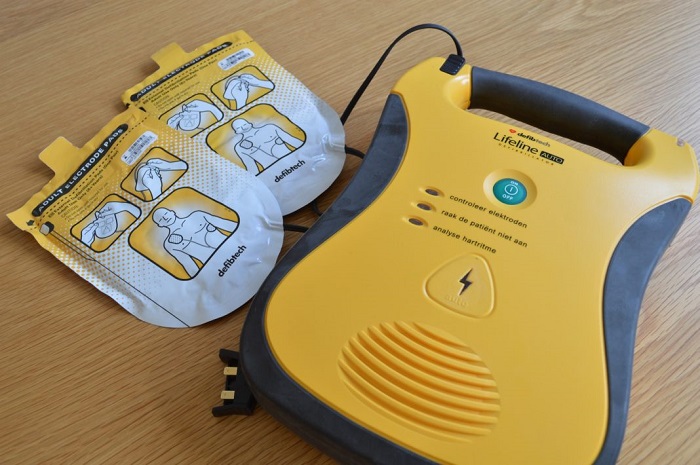Why You Should Know CPR, and Where to Learn it for Free

AED with attached pads
Every minute that passes without CPR, Cardiopulmonary Resuscitation, during cardiac arrest decreases a persons survival rate by 7-10%. People commonly get cardiac arrest and heart attack confused: The key difference is that in cardiac arrest, the heart malfunctions and stops beating (“electrical” problem), while a heart attack occurs when blood flow to the heart is blocked (“circulation” problem). Most heart attacks do not lead to cardiac arrest, but when cardiac arrest occurs, heart attack is a common cause.
If someone is undergoing cardiac arrest, act fast and begin CPR. Taking action as quick as possible will also lead to improved neurological complications that could occur from a lack of oxygen getting to vital organs, like the brain. Performing CPR in a stressful situation may seem daunting (or maybe even impossible), but that’s where knowledge and practice comes into play. When you understand how to perform CPR, and know what to do, the more likely you could be someone’s, maybe even your parents’ or grandparents’, life savior.
How is CPR performed?
Here is a quick breakdown of who should perform CPR and how, courtesy of cpr.heart.org:
1. For healthcare providers and those trained: conventional CPR using chest compressions and mouth-to-mouth breathing at a ratio of 30:2 compressions-to-breaths. In adult victims of cardiac arrest, it is reasonable for rescuers to perform chest compressions at a rate of 100 to 120/min and to a depth of at least 2 inches (5 cm) for an average adult, while avoiding excessive chest compression depths (greater than 2.4 inches [6 cm]).
2. For the general public or bystanders who witness an adult suddenly collapse: compression-only CPR, or Hands-Only CPR. Hands-Only CPR is CPR without mouth-to-mouth breaths. It is recommended for use by people who see a teen or adult suddenly collapse in an out-of-hospital setting (such as at home, at work, or in a park).
But, rather than me explaining in further detail exactly what to do, I encourage everyone to take a class to practice the skills with a licensed professional.
Unsure of where to attend a class? Blue Cross Blue Shield of Minnesota has three retail locations, Edina, Roseville, and Duluth. Every month they offer a variety of FREE classes*, including CPR. If you go online after the class, you can pay $25 and get certified as well.
Since it had been some years (okay, many years), I decided to take a class and brush up on my CPR skills. A few things have changed and been updated, most importantly the use of an Automated External Defibrillator (AED). When used properly, an AED can double, or even triple, a person’s chances for survival.
Steve, a local St. Paul firefighter taught BCBS the course I attended. He explained that people who use AEDs often use them incorrectly, as they don’t always take the time to follow the directions. Each audio AED will walk you step-by-step through the order in which to attach the pads, step away from the patient, begin CPR, and so on.
After trying it myself, over and over and over, I began to understand why people may not listen and follow: People ultimately want to help (and that’s great), but you must wait for instructions and allow the machine to analyze the rhythm of the heart. During these 2 minute or less downtimes, that’s when you should be verifying that help is on the way (someone called 9-1-1), that the area is safe, and that someone is watching for the ambulance or trained medical staff to arrive on site.
A few key things to know about using AED’s: They will only deliver a shock if it’s needed. The machine analyzes the hearts rhythm between the pads (pictures on the pads depict exactly where to place), so you cannot accidentally get shocked as some believe. If the pads do not stick because of hair, you may need to shave the area first before applying. Your first aid kit should have a razor if the AED doesn’t have one. Lastly, if you see bulge under the skin where you are to place the pads, it could be an implant. Do not put the patch over this, place the pads beside it. Medication patches should also be removed.
Story Credit: https://tcagenda.com/2018/know-cpr-learn-free/


